
Zloglasni art-filmovi o nekrofiliji, serijskim ubojicama, krajnjem seksualnom i fizičkom nasilju. Filmski kondomi za prelaženje svih granica podnošljivog.
Buttgereitova web-stranica
Filmovi:
2011: Making of Süsse Stuten 8 (actor, web series)
2011: Shaolin Affen (music-clip for "Osaka Popstar" & Klaus Beyer)
2010: Into the night with Oda Jaune and Lars Eidinger (French /German TV)
2009: Monsterland
2009: Captain Berlin versus Hitler
2008: Making of Süsse Stuten 7 (actor, web series)
2007: Into the night with Joe Coleman und Asia Argento
2007: Into the night with Mark Benecke und Michaela Schaffrath
2006: Into the night with Bruce LaBruce und Jörg Buttgereit (as himself)
2004: Journey into Bliss (Special effects supervisor, actor)
2002: Die Monsterinsel aka Monster Island (German TV)
2001: Missy Queen’s Gonna Die (music-clip for "Tok Tok")
1998: Lexx - The Series "791" (director)
1998: Lexx - The Series "Nook" (Show producer)
1998: Teenagemakeup (musik-Clip for "Dance or Die")
1997: Die gläsernen Sarkophage (TV)
1996: The Killer Condom (special effects)
1995: I can't let go (music-clip for "Shock Therapy")
1993: The Making of Schramm
1992: Schramm - Into the Mind of a Serial Killer
1992: Corpse Fucking Art
1991: Nekromantik 2 - Return of the loving Dead
1989: Der Todesking aka The Death King
1987: Nekromantik
1986: Jesus - The Film
1985: Hot Love
1984: So war das S.O.36 (co-director)
1984: Horror Heaven
1983: Der Gollob
1982: Captain Berlin - Retter der Welt
1982: Der Trend – Punkrocker erzählen aus ihrem Leben
1982: Bloody Excess in the Leaders Bunker
1981: Mein Papi aka My Daddy
1981: Manne -The Movie
1981: Ogar der Häßliche
1981: The Exploding Sportshoe
2011: Shaolin Affen (music-clip for "Osaka Popstar" & Klaus Beyer)
2010: Into the night with Oda Jaune and Lars Eidinger (French /German TV)
2009: Monsterland
2009: Captain Berlin versus Hitler
2008: Making of Süsse Stuten 7 (actor, web series)
2007: Into the night with Joe Coleman und Asia Argento
2007: Into the night with Mark Benecke und Michaela Schaffrath
2006: Into the night with Bruce LaBruce und Jörg Buttgereit (as himself)
2004: Journey into Bliss (Special effects supervisor, actor)
2002: Die Monsterinsel aka Monster Island (German TV)
2001: Missy Queen’s Gonna Die (music-clip for "Tok Tok")
1998: Lexx - The Series "791" (director)
1998: Lexx - The Series "Nook" (Show producer)
1998: Teenagemakeup (musik-Clip for "Dance or Die")
1997: Die gläsernen Sarkophage (TV)
1996: The Killer Condom (special effects)
1995: I can't let go (music-clip for "Shock Therapy")
1993: The Making of Schramm
1992: Schramm - Into the Mind of a Serial Killer
1992: Corpse Fucking Art
1991: Nekromantik 2 - Return of the loving Dead
1989: Der Todesking aka The Death King
1987: Nekromantik
1986: Jesus - The Film
1985: Hot Love
1984: So war das S.O.36 (co-director)
1984: Horror Heaven
1983: Der Gollob
1982: Captain Berlin - Retter der Welt
1982: Der Trend – Punkrocker erzählen aus ihrem Leben
1982: Bloody Excess in the Leaders Bunker
1981: Mein Papi aka My Daddy
1981: Manne -The Movie
1981: Ogar der Häßliche
1981: The Exploding Sportshoe
THE BUTTGEREIT BACKGROUND
Born in 1963, the year following the Oberhausen Manifesto’s demands for a “new German feature film” predicated upon “new freedoms,” liberated from “the influence of commercial partners” and “the control of special interest groups,” Buttgereit received his first Super-8 camera as a First Holy Communion present.
He made his first film in 1977, as West Germany veered to the political right and various left wing, feminist, anti-establishment and terrorist groups such as the Red Army Faction and the Baader-Meinhoff group came to the cultural and political fore. In the face of ideological divisions at the heart of West German society, and the evolution of Alexander Kluge’s Young German Cinema into the distinctively historically engaged New German Cinema, it is notable that whilst Buttgereit’s early film career ranged across genres (from parodic monster and super-hero shorts to mock-rockumentaries set in the West Berlin punk scene) it is still possible to trace a culturally engaged thematic continuity across these early works that is of great relevance to German cinema of the period in general, and the NEKROMANTIK movies in particular.
In 1981, Buttgereit covertly shot the seven minute short MEIN PAPI, a slice of cinema verité displaying for ridicule Buttgereit’s elderly, overweight and vest-clad father. The film was screened in clubs, with Buttgereit being paid for his art in vodka. The real payment, however, as the director remarked in interview with David Kerekes, was the satisfaction of having “whole audiences laughing at his father behind his back.”
The New German Cinema’s location, in Thomas
Elsaesser’s words, of “history in the home and Fascism in the family
unit” was here transmuted into a punkish mockery of the father as
legitimate familial embodiment of totalitarian authority and law. It was
a mockery echoed the following year, in BLOODY EXCESSES IN THE LEADERS BUNKER
, a six minute Super-8 short set in the final days of the Reich, with
Hitler played by a performer better known for his obscene parodies of
the much-loved folk musician Heino and Buttgereit playing his assistant.
Whilst the Heino impersonator went down very well with contemporary
audiences, it is nonetheless notable that Buttgereit’s onetime inclusion
of genuine concentration camp footage in the film, proved too strong
even for the punk denizens of the Berlin music scene.
It underscored, however, Buttgereit’s own decidedly
inventive take on his nation’s past, and the connection of that past to
the politically divided and culturally confused present – a concern that
would, most certainly, feed into the NEKROMANTIK films.
In 1985 came HOT LOVE, a self-consciously absurd tale of sexual infidelity, rape, suicide and the slaughter of the transgressive mother by a murderously mutant newborn: the present born of parental sin, the past avenged, the body bloodied and broken, dark humour inescapable. Finally, with the Buttgereit-directed crucifixion sequence in Michael Brynntup’s JESUS – THE FILM (1985-6) in which Christ (in vampire teeth) is simultaneously nailed to the cross and staked through the heart, the director’s thematic machinery, and collection of collaborators was complete.
Buttgereit, like Syberberg, evidently recognised that strand of Romantic irrationalism that had lain at the heart of German culture long before the originary unification of the nation in the 1870s – an irrationalism that had manifested itself in Goethe’s rendering of the Faust legend, Hoffman’s tales of the unheimlich in prose and later still the horror tales of Weimar cinema – such as Wiene’s THE CABINET OF DR. CALIGARI (1919) or Murneau’s NOSFERATU (1922).
In 1985 came HOT LOVE, a self-consciously absurd tale of sexual infidelity, rape, suicide and the slaughter of the transgressive mother by a murderously mutant newborn: the present born of parental sin, the past avenged, the body bloodied and broken, dark humour inescapable. Finally, with the Buttgereit-directed crucifixion sequence in Michael Brynntup’s JESUS – THE FILM (1985-6) in which Christ (in vampire teeth) is simultaneously nailed to the cross and staked through the heart, the director’s thematic machinery, and collection of collaborators was complete.
Buttgereit, like Syberberg, evidently recognised that strand of Romantic irrationalism that had lain at the heart of German culture long before the originary unification of the nation in the 1870s – an irrationalism that had manifested itself in Goethe’s rendering of the Faust legend, Hoffman’s tales of the unheimlich in prose and later still the horror tales of Weimar cinema – such as Wiene’s THE CABINET OF DR. CALIGARI (1919) or Murneau’s NOSFERATU (1922).
Like Syberberg before him, I would argue, Buttgereit
also recognised “the emotional deadness of German society” engendered
by the Nazi appropriation of that Romantic tradition and focused in his
films on Germany’s subsequent repression both of the memory of the Nazi
past and the irrationalism that underscored it, leaving Germany
“spiritually disinherited and dispossessed … a country without a
homeland, without ‘Heimat.”” For if Syberberg, had had the
quintessentially irrational Germanic unconscious rise from the grave in
the guise of the Führer in HITLER – A FILM FROM GERMANY (1977) then in
the NEKROMANTIK movies Buttgereit would undertake a considerably more
visceral, but no less politically serious, act of resurrection.
Linnie Blake
Linnie Blake
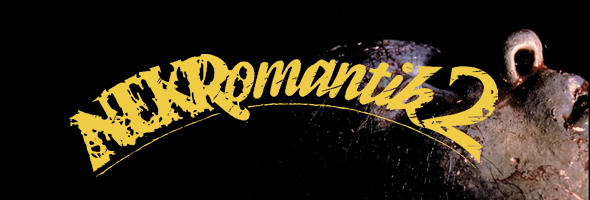
Color, 1991, 104m. / Directed by Jörg Buttgereit / Starring Monika M., Mark Reeder / Barrel (US R1 NTSC) / DD2.0
How do you outdo one of the most notorious, extreme splatter movies ever
made? Simple: make an art film. Though still chock full of the usual
body bonking and assorted gross outs, this is a far more elegant and
polished piece of work than its predecessor, more concerned with a mood
of unease and melancholia than spraying bodily fluids (until the last
five minutes, anyway).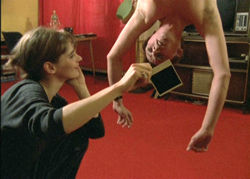 Beautiful young nurse and fledgling necrophile Monika (Monika M.) steals
into a graveyard and digs up the rotting corpse of Rob, our hero from
the first film. She takes his congealed remains home and deposits him in
the bathtub, where does some impromptu prep work and dresses him up to
pose for homemade photographs. Of course, our happy couple becomes a
love triangle thanks to Mark (Mark Reeder), a nice but slightly kinky
guy who makes his living dubbing and providing sound effects(!) for
hardcore porn films. When she isn't at home spending quality time with
deadbeat Rob, Monika goes with Mark to pretentious art films and watches
seal brutality videos, occasionally suspending him naked by his feet.
The strain soon takes its toll, however, and Monika devises an ingenious
and thoroughly perverse solution for the two suitors in her life.
Beautiful young nurse and fledgling necrophile Monika (Monika M.) steals
into a graveyard and digs up the rotting corpse of Rob, our hero from
the first film. She takes his congealed remains home and deposits him in
the bathtub, where does some impromptu prep work and dresses him up to
pose for homemade photographs. Of course, our happy couple becomes a
love triangle thanks to Mark (Mark Reeder), a nice but slightly kinky
guy who makes his living dubbing and providing sound effects(!) for
hardcore porn films. When she isn't at home spending quality time with
deadbeat Rob, Monika goes with Mark to pretentious art films and watches
seal brutality videos, occasionally suspending him naked by his feet.
The strain soon takes its toll, however, and Monika devises an ingenious
and thoroughly perverse solution for the two suitors in her life.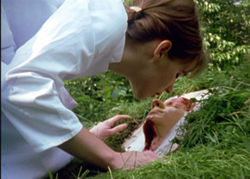
Best known as the film that finally sent the German censors over the deep end (including a well-publicized theatrical raid), Nekromantik 2
uses its comparatively lavish running time for a more ambitious and
densely textured narrative. While the corpse scenes are naturally
gruesome, there's a strong surrealist sensibility at work that keeps it
more curious than repellent. Apart from the aforementioned seal scene,
an ill-advised attempt to outdo the bunny footage from the original
film, Buttgereit strangely avoids any graphic bloodshed or nasty latex
dismemberments for most of the running time. Of course, he's really just
saving it up for the powerhouse finale, which amazingly outdoes the
Daktari Lorenz's "climax" from Nekromantik. The narrative also
has a stronger pull in this case, stopping along the way for some
humorous and romantic asides before the ironic final scene. Much credit
must also go to the alluring Monika M., a terrific lead who should have
gone on to do far more work. (She even chipped in on the lyrical music
score, along with five other people!)
As with the film itself, Barrel's meticulous DVD outdoes the original in
terms of sheer volume. The transfer itself is quite startling for a
16mm film; colors are extremely vibrant and detail is razor sharp. Some
minor blemishes pop up along with the occasional rough splice, but most
viewers are unlikely to notice. 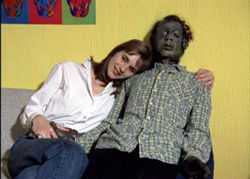 It's
a wonderful-looking presentation, even more miraculous than the
overhaul performed on the Super-8 first film. The new stereo mix is
mostly confined to the music, while the mono original is retained as
well; the optional English subtitles are always legible and
well-written. Buttgereit returns for another commentary along with
co-writer Franz Rodenkirchen and the two lead actors; it's a highly
enjoyable and informative track, ranging from discussions of the
extensive make-up appliances to the censorship hassles to the
cameraderie behind the scenes. "The Making of Nekromantik 2" is basically a repurposed version of the half hour of making-of footage from the Buttgereit documentary, Corpse F*cking Art;
the creation of Rob's corpse is especially interesting to watch and
makes one very, very sorry for the poor actor, whose ordeal wouldn't be
out of place in a Jackass episode. Also included: German radio
interviews with Buttgereit and Rodenkirchen (with optional subs); "Rise
Up" (a heavy metal music video for The Krupps directed by Buttgereit);
"Manne: The Movie," an early Super-8 Buttgereit film apparently done as a
lark; a reel of outtakes showing bloopers and the crew at work on the
set; a huge still gallery; trailers for the Nekromantik films along with Schramm and Der Todesking;
a hidden peek at a Buttgereit-designed video game; and of course, the
usual filmographies. David Kerekes and Buttgereit contribue liner notes
to the extensive booklet, and the first 20,000 units include a second
bonus disc, a soundtrack CD containing music from both Nekromantik
films along with extra tracks (cover and alternate versions). The first
handful of tracks are in mono, but have no fear; most of the music from
both films is in beautiful stereo and would stand as a particularly odd
New Age album on its own terms.
It's
a wonderful-looking presentation, even more miraculous than the
overhaul performed on the Super-8 first film. The new stereo mix is
mostly confined to the music, while the mono original is retained as
well; the optional English subtitles are always legible and
well-written. Buttgereit returns for another commentary along with
co-writer Franz Rodenkirchen and the two lead actors; it's a highly
enjoyable and informative track, ranging from discussions of the
extensive make-up appliances to the censorship hassles to the
cameraderie behind the scenes. "The Making of Nekromantik 2" is basically a repurposed version of the half hour of making-of footage from the Buttgereit documentary, Corpse F*cking Art;
the creation of Rob's corpse is especially interesting to watch and
makes one very, very sorry for the poor actor, whose ordeal wouldn't be
out of place in a Jackass episode. Also included: German radio
interviews with Buttgereit and Rodenkirchen (with optional subs); "Rise
Up" (a heavy metal music video for The Krupps directed by Buttgereit);
"Manne: The Movie," an early Super-8 Buttgereit film apparently done as a
lark; a reel of outtakes showing bloopers and the crew at work on the
set; a huge still gallery; trailers for the Nekromantik films along with Schramm and Der Todesking;
a hidden peek at a Buttgereit-designed video game; and of course, the
usual filmographies. David Kerekes and Buttgereit contribue liner notes
to the extensive booklet, and the first 20,000 units include a second
bonus disc, a soundtrack CD containing music from both Nekromantik
films along with extra tracks (cover and alternate versions). The first
handful of tracks are in mono, but have no fear; most of the music from
both films is in beautiful stereo and would stand as a particularly odd
New Age album on its own terms.
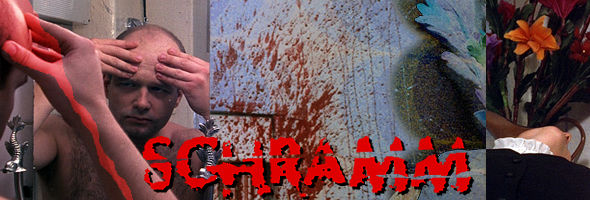
Color,
1993, 65 mins. / Directed by Jörg Buttgereit / Starring Florian
Koerner, Monika M., Franz Rodenkirchen / Barrel (US R1 NTSC) / DD2.0
Stereo
Hardly your average splatter director, Jörg Buttgereit has confounded
critics by mixing high art aesthetics with painfully explicit
bloodletting and sexual depravity, resulting in peculiar, downbeat
hybrids like Nekromantik 2 and Der Todesking. Nowhere is
this dichotomy more troubling than in Schramm, the director’s concession to the serial 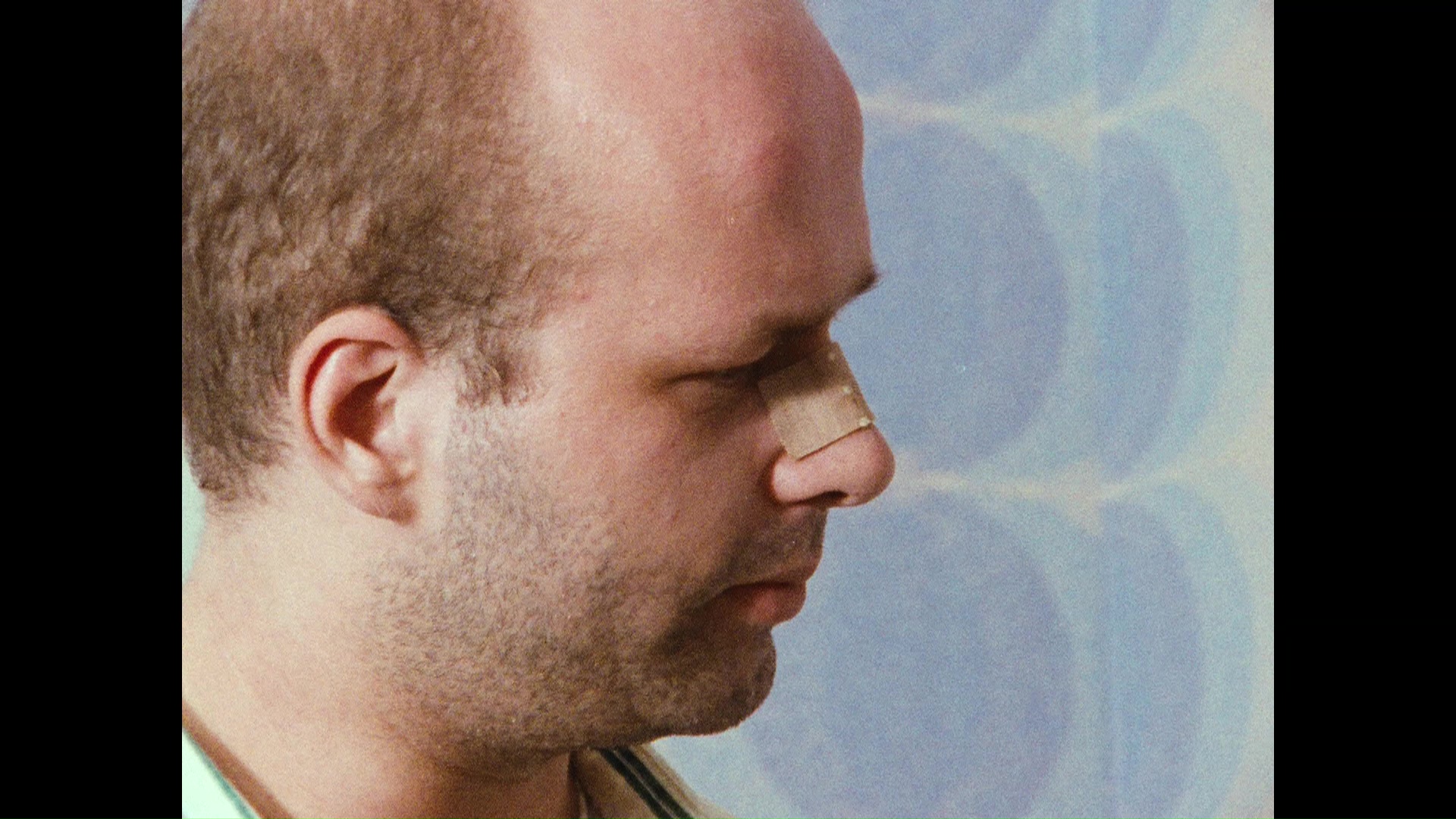 killer craze which dominated horror during the 1990s. However, this is truly unlike any other psycho movie ever made.
killer craze which dominated horror during the 1990s. However, this is truly unlike any other psycho movie ever made.
The nonlinear story begins with taxi driver and troubled murderer Lothar
Schramm (former porn actor Florian Koerner) plunging from a ladder while
painting his walls. One of apparently artificial legs pops off, and he
crashes to the wooden floor, evidently in his death throes. The film
then switches into partial reverse, introducing a pair of door to door
religious converters who wind up on the wrong end of Schramm’s knife.
Gradually the layers are peeled away as we see Schramm living a
tormented existence as the "Lipstick Killer," who drugs and photographs
his female victims, adorns their lips with rouge, and then sometimes
kills them. He also develops a crush on svelte hooker Marianna (Monika
M.) and suffers through terrifying, blackly comic fantasies involving
eyeball-plucking dentists, furry vagina monsters with teeth, and much
more. Of course, that’s nothing  compared to the self-mutilation ritual
he performs on his most sensitive bodily area with a hammer and some
nails, so the squeamish would be well advised to steer clear. Eventually
the whole story comes full circle as we come to experience the numbing
day to day experience which can turn even the quietest guy next door
into a potential menace.
compared to the self-mutilation ritual
he performs on his most sensitive bodily area with a hammer and some
nails, so the squeamish would be well advised to steer clear. Eventually
the whole story comes full circle as we come to experience the numbing
day to day experience which can turn even the quietest guy next door
into a potential menace.
As most readers can probably guess from the synopsis, Schramm is
not a film for everybody and won’t be a good choice to convert the
uninitiated into the realm of European horror. However, adventurous
souls will be more receptive to Buttgereit’s quirky vision, which has
become more refined and impressive with each film. (Unfortunately, this
remains his last directorial effort to date.) As usual, some of his
camera angles and his use of music are extremely impressive considering
the limited financial means, and some of the special effects are a
little too realistic for comfort.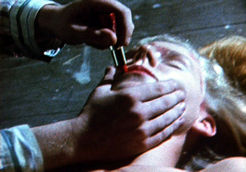
For a 16mm title, Schramm looks very impressive on DVD. The image
displays virtually no grain or instability at all (apart from some
visually distorted dream sequences), while colors are smooth and often
vibrant. The newly remixed stereo soundtrack is focused primarily on the
music, which benefits greatly from the extra sonic field, though the
original mono soundtrack is also included for purists. The sharp
optional subtitles are also a huge relief after years of blurry,
unwatchable bootleg videotapes. As with Barrel’s
Nekromantik release, the disc is stuffed with a staggering array
of extras (both advertised and hidden), starting with a commentary
track by Buttgereit himself with co-writer Franz Rodenkirchen (also in
the film as a dentist); the film maker remains as self-deprecating and
insightful as always. An alternate commentary track by Koerner and
Monika M. proves to be somewhat juicier, including some frank
revelations about the various simulated sexual scenes scattered
throughout the movie.
Other extras both big and small: The Making of Schramm, a frank
half hour documentary built around Koerner interview footage and
exhibitionistic behind the scenes footage; a Buttgereit music video clip
for the group Mutter entitled "Die Neue Zeit;" a huge number of candid
shots from the film's shooting; trailers for Schramm, Nekromantik (two versions), Der Todesking, and Nekromantik 2;
two subtitled short films, "Mein Papi" and "Captain Berlin," which show
off the director's emotional and goofy sides, respectively; and an
Easter Egg feature which leads to a banned four minute profile of
Buttgereit prepared for Britain's Channel Four but never aired.
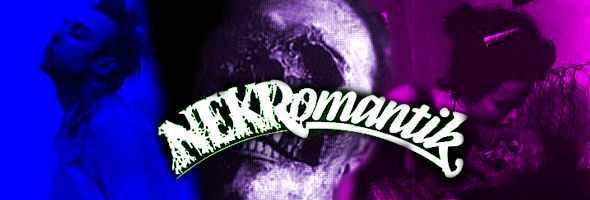
Color,
1987, 71m. / Directed by Jörg Buttgereit / Starring Daktari Lorenz,
Beatrice M., Harald Lundt, Susa Kohlstedt / Barrel (US R1 NTSC) / DD2.0
Less a traditional movie experience than a slimy slap in the face, Nekromantik
was an instrumental title in the '80s gore renaissance and quickly
passed in bootleg form from one eager collector to another, long before
its official and short-lived VHS debut through Film Threat
magazine. Unlike many German horror films which fail to distinguish
themselves apart from the sheer level of bodily fluid spilled in front
of the camera (e.g., The German Chainsaw Massacre and Violent Sh*t), Nekromantik
at least demonstrates some level of talent behind the camera and led
director Jörg Buttgereit on a strange career which is hopefully far from
over. How enjoyable this film will be, however, depends entirely on
each viewer's individual sensitivities.
Quiet little Rob (Daktari  Lorenz)
seems like such a happy guy. Every day he goes to work for Joe's
Streetcleaning Agency, where he and his coworkers clean up the gory
remains of car accidents, and he goes home at night to his girlfriend,
Betty (Beatrice Manowski, who later turned up in Wim Wenders' Wings of Desire
the same year!). The young lovers display an unhealthy fascination with
all things dead, so Rob decides to spice up their sex life by bringing
home - yup - a corpse. With the aid of a few household implements, they
engage in a sticky menage a trois which should cause most sane viewers
to flee for the nearest exit. When Rob loses his job, Betty takes off
with the corpse and leaves him a farewell note. Unfortunately he's
unable to cope with single life and experiments with various ways of
recapturing that old magic, with one unforgettable bit involving a handy
prostitute. If this all sounds too warped, well, just wait until the
last five minutes...
Lorenz)
seems like such a happy guy. Every day he goes to work for Joe's
Streetcleaning Agency, where he and his coworkers clean up the gory
remains of car accidents, and he goes home at night to his girlfriend,
Betty (Beatrice Manowski, who later turned up in Wim Wenders' Wings of Desire
the same year!). The young lovers display an unhealthy fascination with
all things dead, so Rob decides to spice up their sex life by bringing
home - yup - a corpse. With the aid of a few household implements, they
engage in a sticky menage a trois which should cause most sane viewers
to flee for the nearest exit. When Rob loses his job, Betty takes off
with the corpse and leaves him a farewell note. Unfortunately he's
unable to cope with single life and experiments with various ways of
recapturing that old magic, with one unforgettable bit involving a handy
prostitute. If this all sounds too warped, well, just wait until the
last five minutes...
A film whose reputation rests mostly on its lurid title, Nekromantik
is at least not as realistic as one might fear. The special effects by
and large are competent but exaggerated to the point of black comedy,
such as a partial shovel decapitation that seems to have strayed in from
a Peter Jackson film. The potential for black humor isn't squandered,
either, with the funniest bit involving Rob's reaction when he stumbles
into a theater showing a slasher film (with the soundtrack of Lucio
Fulci's Zombie!). All of this would be far more unbearable
without the excellent music score, partially composed by Lorenz himself,
one of the finest and most memorable to grace an '80s horror film.
Shot 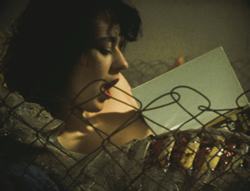 on 8mm and blown up to 16mm for theatrical and video screenings, Nekromantik
has always looked quite rough. The DVD doesn't seem too promising at
first, with that notorious opening scene (at night, natch) still grainy
and muddy as always. After that, however, this is a Nekromantik
you've never seen before. The image is extraordinarily good for 8mm (a
first for a DVD feature?), and even on the big screen it could probably
never look this good. Contrary to the packaging, the soundtrack is
presented in a modest stereo mix which makes this film feel a lot more
slick than it probably should. The channel separation during the music
is very satisfying, with some hilarious directional effects tossed into
the mix as well. The stereo is also more prominent and balanced when
played in simple two channel stereo rather than simulated Dolby Digital
surround; a very impressive job all around. Even those who hate the
movie (and they probably outnumber the film's fans) should be impressed
by the wealth of extras, including much participation by Buttgereit
himself. Gorehounds in the late '80s speculated that he must be one of
those creepy guys you'd never want to meet in person, but in fact he's a
clean cut, charming guy with an obvious love for horror films and a
quirky sense of humor. As anyone who heard his commentary on Combat Shock and Killer Condom can attest, he's good company for an entire film and really needs to make another feature after his underrated Schramm.
He even offers some semblance of a defense for the film's most
objectionable and repulsive sequence(s), the actual killing and skinning
of a rabbit: "Just because we show it doesn't mean we like it."
Apparently this activity was filmed during the day-to-day activity on a
rabbit farm, but that doesn't make it any easier to watch. Cowriter
Franz Rodenkirchen also chimes in on the commentary track and proves to
be just as personable as the director, who also hosts a short making-of
featurette packed with behind the scenes photos and anecdotes. Another
brief feature, The Making of Nekromantik, covers similar ground
in a more documentary style fashion, with a series of outtakes and
clips. An incredibly lavish still gallery is accompanied by what appears
to be the film's entire score, isolated in perfect stereo sound. Not
enough, you say? Buttgereit's early short film, Horror Heaven,
also turns up and sports loving homages to The Mummy, Frankenstein,
cannibal girl flicks, and most amusingly Godzilla, all hosted in
quasi-Hitchcock style by the director himself. His other work is
represented by two(!) Nekromantik trailers as well as previews for Der Tödesking, Nekromantik 2, and Schramm. And for you Easter Egg hunters out there, be sure to check his filmography under Corpse F*cking Art. An exhaustive, amazing, and very dangerous experience indeed.
on 8mm and blown up to 16mm for theatrical and video screenings, Nekromantik
has always looked quite rough. The DVD doesn't seem too promising at
first, with that notorious opening scene (at night, natch) still grainy
and muddy as always. After that, however, this is a Nekromantik
you've never seen before. The image is extraordinarily good for 8mm (a
first for a DVD feature?), and even on the big screen it could probably
never look this good. Contrary to the packaging, the soundtrack is
presented in a modest stereo mix which makes this film feel a lot more
slick than it probably should. The channel separation during the music
is very satisfying, with some hilarious directional effects tossed into
the mix as well. The stereo is also more prominent and balanced when
played in simple two channel stereo rather than simulated Dolby Digital
surround; a very impressive job all around. Even those who hate the
movie (and they probably outnumber the film's fans) should be impressed
by the wealth of extras, including much participation by Buttgereit
himself. Gorehounds in the late '80s speculated that he must be one of
those creepy guys you'd never want to meet in person, but in fact he's a
clean cut, charming guy with an obvious love for horror films and a
quirky sense of humor. As anyone who heard his commentary on Combat Shock and Killer Condom can attest, he's good company for an entire film and really needs to make another feature after his underrated Schramm.
He even offers some semblance of a defense for the film's most
objectionable and repulsive sequence(s), the actual killing and skinning
of a rabbit: "Just because we show it doesn't mean we like it."
Apparently this activity was filmed during the day-to-day activity on a
rabbit farm, but that doesn't make it any easier to watch. Cowriter
Franz Rodenkirchen also chimes in on the commentary track and proves to
be just as personable as the director, who also hosts a short making-of
featurette packed with behind the scenes photos and anecdotes. Another
brief feature, The Making of Nekromantik, covers similar ground
in a more documentary style fashion, with a series of outtakes and
clips. An incredibly lavish still gallery is accompanied by what appears
to be the film's entire score, isolated in perfect stereo sound. Not
enough, you say? Buttgereit's early short film, Horror Heaven,
also turns up and sports loving homages to The Mummy, Frankenstein,
cannibal girl flicks, and most amusingly Godzilla, all hosted in
quasi-Hitchcock style by the director himself. His other work is
represented by two(!) Nekromantik trailers as well as previews for Der Tödesking, Nekromantik 2, and Schramm. And for you Easter Egg hunters out there, be sure to check his filmography under Corpse F*cking Art. An exhaustive, amazing, and very dangerous experience indeed.

 killer craze which dominated horror during the 1990s. However, this is truly unlike any other psycho movie ever made.
killer craze which dominated horror during the 1990s. However, this is truly unlike any other psycho movie ever made.
The nonlinear story begins with taxi driver and troubled murderer Lothar Schramm (former porn actor Florian Koerner) plunging from a ladder while painting his walls. One of apparently artificial legs pops off, and he crashes to the wooden floor, evidently in his death throes. The film then switches into partial reverse, introducing a pair of door to door religious converters who wind up on the wrong end of Schramm’s knife. Gradually the layers are peeled away as we see Schramm living a tormented existence as the "Lipstick Killer," who drugs and photographs his female victims, adorns their lips with rouge, and then sometimes kills them. He also develops a crush on svelte hooker Marianna (Monika M.) and suffers through terrifying, blackly comic fantasies involving eyeball-plucking dentists, furry vagina monsters with teeth, and much more. Of course, that’s nothing
 compared to the self-mutilation ritual
he performs on his most sensitive bodily area with a hammer and some
nails, so the squeamish would be well advised to steer clear. Eventually
the whole story comes full circle as we come to experience the numbing
day to day experience which can turn even the quietest guy next door
into a potential menace.
compared to the self-mutilation ritual
he performs on his most sensitive bodily area with a hammer and some
nails, so the squeamish would be well advised to steer clear. Eventually
the whole story comes full circle as we come to experience the numbing
day to day experience which can turn even the quietest guy next door
into a potential menace.
As most readers can probably guess from the synopsis, Schramm is not a film for everybody and won’t be a good choice to convert the uninitiated into the realm of European horror. However, adventurous souls will be more receptive to Buttgereit’s quirky vision, which has become more refined and impressive with each film. (Unfortunately, this remains his last directorial effort to date.) As usual, some of his camera angles and his use of music are extremely impressive considering the limited financial means, and some of the special effects are a little too realistic for comfort.

For a 16mm title, Schramm looks very impressive on DVD. The image displays virtually no grain or instability at all (apart from some visually distorted dream sequences), while colors are smooth and often vibrant. The newly remixed stereo soundtrack is focused primarily on the music, which benefits greatly from the extra sonic field, though the original mono soundtrack is also included for purists. The sharp optional subtitles are also a huge relief after years of blurry, unwatchable bootleg videotapes. As with Barrel’s Nekromantik release, the disc is stuffed with a staggering array of extras (both advertised and hidden), starting with a commentary track by Buttgereit himself with co-writer Franz Rodenkirchen (also in the film as a dentist); the film maker remains as self-deprecating and insightful as always. An alternate commentary track by Koerner and Monika M. proves to be somewhat juicier, including some frank revelations about the various simulated sexual scenes scattered throughout the movie.
Other extras both big and small: The Making of Schramm, a frank half hour documentary built around Koerner interview footage and exhibitionistic behind the scenes footage; a Buttgereit music video clip for the group Mutter entitled "Die Neue Zeit;" a huge number of candid shots from the film's shooting; trailers for Schramm, Nekromantik (two versions), Der Todesking, and Nekromantik 2; two subtitled short films, "Mein Papi" and "Captain Berlin," which show off the director's emotional and goofy sides, respectively; and an Easter Egg feature which leads to a banned four minute profile of Buttgereit prepared for Britain's Channel Four but never aired.

Color,
1987, 71m. / Directed by Jörg Buttgereit / Starring Daktari Lorenz,
Beatrice M., Harald Lundt, Susa Kohlstedt / Barrel (US R1 NTSC) / DD2.0
Less a traditional movie experience than a slimy slap in the face, Nekromantik
was an instrumental title in the '80s gore renaissance and quickly
passed in bootleg form from one eager collector to another, long before
its official and short-lived VHS debut through Film Threat
magazine. Unlike many German horror films which fail to distinguish
themselves apart from the sheer level of bodily fluid spilled in front
of the camera (e.g., The German Chainsaw Massacre and Violent Sh*t), Nekromantik
at least demonstrates some level of talent behind the camera and led
director Jörg Buttgereit on a strange career which is hopefully far from
over. How enjoyable this film will be, however, depends entirely on
each viewer's individual sensitivities.
Quiet little Rob (Daktari  Lorenz)
seems like such a happy guy. Every day he goes to work for Joe's
Streetcleaning Agency, where he and his coworkers clean up the gory
remains of car accidents, and he goes home at night to his girlfriend,
Betty (Beatrice Manowski, who later turned up in Wim Wenders' Wings of Desire
the same year!). The young lovers display an unhealthy fascination with
all things dead, so Rob decides to spice up their sex life by bringing
home - yup - a corpse. With the aid of a few household implements, they
engage in a sticky menage a trois which should cause most sane viewers
to flee for the nearest exit. When Rob loses his job, Betty takes off
with the corpse and leaves him a farewell note. Unfortunately he's
unable to cope with single life and experiments with various ways of
recapturing that old magic, with one unforgettable bit involving a handy
prostitute. If this all sounds too warped, well, just wait until the
last five minutes...
Lorenz)
seems like such a happy guy. Every day he goes to work for Joe's
Streetcleaning Agency, where he and his coworkers clean up the gory
remains of car accidents, and he goes home at night to his girlfriend,
Betty (Beatrice Manowski, who later turned up in Wim Wenders' Wings of Desire
the same year!). The young lovers display an unhealthy fascination with
all things dead, so Rob decides to spice up their sex life by bringing
home - yup - a corpse. With the aid of a few household implements, they
engage in a sticky menage a trois which should cause most sane viewers
to flee for the nearest exit. When Rob loses his job, Betty takes off
with the corpse and leaves him a farewell note. Unfortunately he's
unable to cope with single life and experiments with various ways of
recapturing that old magic, with one unforgettable bit involving a handy
prostitute. If this all sounds too warped, well, just wait until the
last five minutes...
A film whose reputation rests mostly on its lurid title, Nekromantik
is at least not as realistic as one might fear. The special effects by
and large are competent but exaggerated to the point of black comedy,
such as a partial shovel decapitation that seems to have strayed in from
a Peter Jackson film. The potential for black humor isn't squandered,
either, with the funniest bit involving Rob's reaction when he stumbles
into a theater showing a slasher film (with the soundtrack of Lucio
Fulci's Zombie!). All of this would be far more unbearable
without the excellent music score, partially composed by Lorenz himself,
one of the finest and most memorable to grace an '80s horror film.
Shot  on 8mm and blown up to 16mm for theatrical and video screenings, Nekromantik
has always looked quite rough. The DVD doesn't seem too promising at
first, with that notorious opening scene (at night, natch) still grainy
and muddy as always. After that, however, this is a Nekromantik
you've never seen before. The image is extraordinarily good for 8mm (a
first for a DVD feature?), and even on the big screen it could probably
never look this good. Contrary to the packaging, the soundtrack is
presented in a modest stereo mix which makes this film feel a lot more
slick than it probably should. The channel separation during the music
is very satisfying, with some hilarious directional effects tossed into
the mix as well. The stereo is also more prominent and balanced when
played in simple two channel stereo rather than simulated Dolby Digital
surround; a very impressive job all around. Even those who hate the
movie (and they probably outnumber the film's fans) should be impressed
by the wealth of extras, including much participation by Buttgereit
himself. Gorehounds in the late '80s speculated that he must be one of
those creepy guys you'd never want to meet in person, but in fact he's a
clean cut, charming guy with an obvious love for horror films and a
quirky sense of humor. As anyone who heard his commentary on Combat Shock and Killer Condom can attest, he's good company for an entire film and really needs to make another feature after his underrated Schramm.
He even offers some semblance of a defense for the film's most
objectionable and repulsive sequence(s), the actual killing and skinning
of a rabbit: "Just because we show it doesn't mean we like it."
Apparently this activity was filmed during the day-to-day activity on a
rabbit farm, but that doesn't make it any easier to watch. Cowriter
Franz Rodenkirchen also chimes in on the commentary track and proves to
be just as personable as the director, who also hosts a short making-of
featurette packed with behind the scenes photos and anecdotes. Another
brief feature, The Making of Nekromantik, covers similar ground
in a more documentary style fashion, with a series of outtakes and
clips. An incredibly lavish still gallery is accompanied by what appears
to be the film's entire score, isolated in perfect stereo sound. Not
enough, you say? Buttgereit's early short film, Horror Heaven,
also turns up and sports loving homages to The Mummy, Frankenstein,
cannibal girl flicks, and most amusingly Godzilla, all hosted in
quasi-Hitchcock style by the director himself. His other work is
represented by two(!) Nekromantik trailers as well as previews for Der Tödesking, Nekromantik 2, and Schramm. And for you Easter Egg hunters out there, be sure to check his filmography under Corpse F*cking Art. An exhaustive, amazing, and very dangerous experience indeed.
on 8mm and blown up to 16mm for theatrical and video screenings, Nekromantik
has always looked quite rough. The DVD doesn't seem too promising at
first, with that notorious opening scene (at night, natch) still grainy
and muddy as always. After that, however, this is a Nekromantik
you've never seen before. The image is extraordinarily good for 8mm (a
first for a DVD feature?), and even on the big screen it could probably
never look this good. Contrary to the packaging, the soundtrack is
presented in a modest stereo mix which makes this film feel a lot more
slick than it probably should. The channel separation during the music
is very satisfying, with some hilarious directional effects tossed into
the mix as well. The stereo is also more prominent and balanced when
played in simple two channel stereo rather than simulated Dolby Digital
surround; a very impressive job all around. Even those who hate the
movie (and they probably outnumber the film's fans) should be impressed
by the wealth of extras, including much participation by Buttgereit
himself. Gorehounds in the late '80s speculated that he must be one of
those creepy guys you'd never want to meet in person, but in fact he's a
clean cut, charming guy with an obvious love for horror films and a
quirky sense of humor. As anyone who heard his commentary on Combat Shock and Killer Condom can attest, he's good company for an entire film and really needs to make another feature after his underrated Schramm.
He even offers some semblance of a defense for the film's most
objectionable and repulsive sequence(s), the actual killing and skinning
of a rabbit: "Just because we show it doesn't mean we like it."
Apparently this activity was filmed during the day-to-day activity on a
rabbit farm, but that doesn't make it any easier to watch. Cowriter
Franz Rodenkirchen also chimes in on the commentary track and proves to
be just as personable as the director, who also hosts a short making-of
featurette packed with behind the scenes photos and anecdotes. Another
brief feature, The Making of Nekromantik, covers similar ground
in a more documentary style fashion, with a series of outtakes and
clips. An incredibly lavish still gallery is accompanied by what appears
to be the film's entire score, isolated in perfect stereo sound. Not
enough, you say? Buttgereit's early short film, Horror Heaven,
also turns up and sports loving homages to The Mummy, Frankenstein,
cannibal girl flicks, and most amusingly Godzilla, all hosted in
quasi-Hitchcock style by the director himself. His other work is
represented by two(!) Nekromantik trailers as well as previews for Der Tödesking, Nekromantik 2, and Schramm. And for you Easter Egg hunters out there, be sure to check his filmography under Corpse F*cking Art. An exhaustive, amazing, and very dangerous experience indeed.

Contrary to popular belief, at least in America, Jörg Buttgereit is not just the director of the arguably notorious NEKROMANTIK. He is also a playwright, a producer, an author, a bastion of good taste, and a sharp dresser.
I had the pleasure of speaking to Mr. Buttgereit a couple weeks ago…AT FOUR IN THE MORNING.
Fortunately, he’s a fascinating individual, and I didn’t fall face-first into my tub of coffee.
Let’s jump right into snappy answers to stupid questions…
Jörg Buttgereit
DIRECTOR, PLAYWRIGHT, PRODUCER, AUTHOR,
AND EVERYTHING ELSE YOU CAN IMAGINE
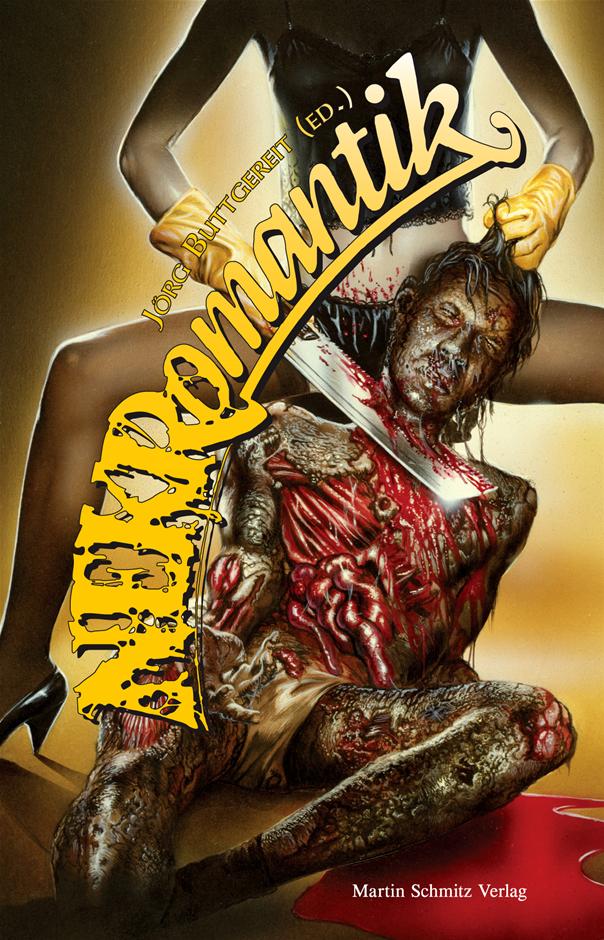
Daily Grindhouse: What was the first movie that changed your life?
Jörg Buttgereit: That’s hard to say, because normally you don’t remember the first thing you see. One of the first memories I have is of a very early Ray Harryhausen movie THE 7TH VOYAGE OF SINBAD – with the Cyclops. That really freaked me out. That was one of the few films shown on TV in Germany. There was no real horror culture in Germany, so films like that on TV were very rare. I think this was the first movie I ever saw.

Do you think there’s a line between making a good film and simply making a film to startle the audience – shock for the sake of shock?
Yes, of course. There are so many films that pretend to be shocking, but they are so bad that the shock doesn’t work. I think the most shocking and disturbing films are never the ones that tell me upfront that the film is shocking. I’m shocked when I’m not expecting a shock. If you speak of NEKROMANTIK, the poster is really shocking, but then you see that the film does not deal with the subject in a shocking way. It pretends that it’s all normal. The topic is shocking in the first place, but the movie deals with the subject like it’s a normal love story. The second part is worse in this case, you only have two or three scenes that are shocking, and the rest is pure love story – which might be shocking to horror fans. You get shocked by things you do not expect. If you can prepare yourself, you are not shocked.
Was your short HOT LOVE somewhat of a precursor to NEKROMANTIK? Did one inspire the other?
No. I got the chance to do NEKROMANTIK because of my collaboration with the producer on a documentary about a famous punk club here in Berlin. Like CBGB’s in New York, we still have a club over here called S.O.36-an old name for the district where the club is located. Manfred Jelinski, the producer, asked me if I could help him with this documentary because I had contacts with the music scene. He looked like a hippie, so he wasn’t even allowed sometimes to go in the club. I contacted all the punk and industrial bands that were popular during that time and we did the documentary film together. After that film – that was in ’84 – he was willing to support me with equipment, editing facilities, and a cameraman to do my first feature film. Before that, he also made the blow-up for HOT LOVE. He had a machine to do film prints from Super 8. When you do Super 8 films, and HOT LOVE is a Super 8 film, you don’t have a negative. You can’t do prints like you can from photos. From the original Super 8 film stock, he made a 16mm blow-up for cinema screens. After that he told me, “We worked together on the documentary film and I’ve seen your last short film. If you want to do a feature film – you won’t get any money – but you can work with my facilities.”
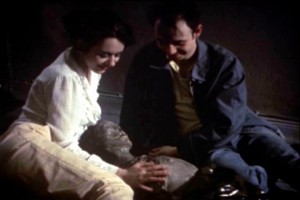
When I watched HOT LOVE, obviously, it’s not the same story as NEKROMANTIK, but it has the same star and a similar feel. Could it be argued that NEKROMANTIK is a love story?
In every love story movie, you have a relationship between three people where something goes wrong. I think that is typical love story stuff. One is dead in NEKROMANTIK. That’s the only difference.
What’s your take on contemporary horror? To me, it seems like the European filmmakers are pushing the boundaries nowadays: You, Srdjan Spasojevich with A SERBIAN FILM, Pascal Laugier with MARTYRS, and even Tom Six with his HUMAN CENTIPEDE series. America seems to be content doing horrible remakes like NIGHTMARE ON ELM STREET, or flaccid original films like INSIDIOUS. Do you feel like Europe is just simply where it’s at for horror that pushes the boundaries?
When I pushed the boundaries 25 years ago, there was really no European horror scene. There was no German horror scene until now. What I did was more like underground filmmaking based on the punk rock movement. When I saw the fringe horror movies like INSIDE or MARTYRS, I noticed they also had good plots. Over here, the movies have disturbing thoughts. They try to do more than an American horror movie likes to do. I think that’s also because in Europe, it’s not so common to deal with horror in entertainment. Here, you need an excuse to do a horror movie, because you have to explain yourself. Over there, in the US, doing a horror movie is nothing special, I suppose. Over here, it is something ‘bad’ in the first place, and you have to explain yourself. In the long run, this might be the reason people have to think more about what they are doing. Maybe European filmmakers are forced to put sense into their movies.
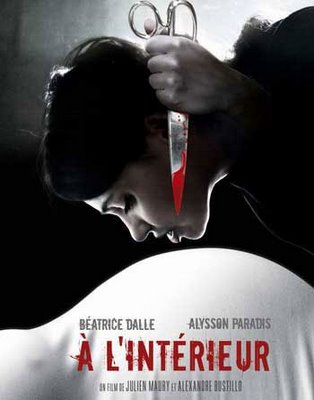
You were saying, especially back in the day, Germany wasn’t making horror movies. German horror seems to be somewhat popular nowadays.
What is German horror?
Olaf Ittenbach’s BURNING MOON, for example; although it came out in the late eighties, it recently had an impressive re-release from Intervision on DVD.
That has nothing to do with any film scene over here. That was just a guy doing his home movies. You can look in a German film dictionary and you won’t find him. You might not even find me. Over here, I’m more known for writing film critiques on horror movies, or writing books about Japanese monster movies. I’m not part of any industry. I started earning money doing films when I stopped doing horror movies. I earn my money with stage plays and radio plays – stuff like this. I’m also kind of bored by horror movies. Someone like Olaf Ittenbach cannot live on making horror movies. There is no film industry; we are not supported in any way. It’s totally different. Sometimes there are films that are more commercial. The producers have it in mind to export the films. If you want to be a filmmaker in Germany, you don’t do horror films. It’s a bad decision. Speaking of a career move, it’s the worst you can make.
Would you consider Uwe Boll to be part of the German horror scene?
When I did films in the eighties, we had to establish our own distribution company, or they wouldn’t have been sent out or even released. We also distributed Uwe Boll’s early films. That’s why I know of his early films. I think he’s a total exception in terms of how many movies he can do and that he earns money with the movies. But his films are totally different from the films I did and the films Ittenbach is doing, because his appeal is totally commercial. I would assume that he doesn’t even think about trying to tell something to the audience. He’s trying to sell something to the audience, that’s his main thing. I think he’s a very clever producer, but not a high-profile filmmaker. I think he directs his films because it’s cheaper for him.

NEKROMANTIK is arguably your most famous-perhaps infamous-film. Is there another movie in your filmography that you feel fell under the radar – maybe didn’t get the attention it deserved?
I’m very surprised I get any attention for my movies at all, because the four feature films I did were films I did on weekends with my friends. This was the internet. The distribution was totally hand-made. We took the film prints to cinemas and showed them. We never sold the movie to a distribution company for royalties. When the VHS video boom came, we released the films on our own. It was very surprising to me that, just a few weeks after we released the first media edition of NEKROMANTIK, I got reviews from the US – because I didn’t bring them there. There were a lot of people who got the movie around – maybe even made money off of it without asking me. The film got attention, but it came from bootlegs. Sometimes I got letters in the eighties asking if the corpses in NEKROMANTIK were real. Nobody would ask me anything like this today, because if you see the film on DVD, you can see that it’s not a real corpse, of course. Back in the day, the bootlegs were so bad that the special effects looked really good.
Do you feel that there’s another movie that should have gotten as much attention as NEKROMANTIK?
I know the second film that I did, DER TODESKING, didn’t get any attention in the early days. Nowadays everyone tells me that this is a much better film than NEKROMANTIK. If you ask our mail order, they will tell you that if we sell ten NEKROMANTIKs, we sell one TODESKING – but everyone tells me that TODESKING is a better movie. That’s strange. I don’t trust this kind of attention, because it’s totally subjective. On the other hand, there’s stuff you don’t even know about in the US. I just did a drama for radio. The translation of the title would be THE BEAST OF FUKUSHIMA. It’s a monster story based on the facts from the disaster at the Fukushima power plant. That just went on nation-wide radio and you can download it from the radio station’s website. I asked my editor from the radio how many people had listened to this. She told me that it will be 100,000 on-air, and a few hundred thousand will download it. But nobody knows about this. The people who listen to my radio plays are a much bigger audience than this little Super 8 movie I did in ’83 or ’84. To me, I get a lot of attention from people who don’t even know that I did NEKROMANTIK.

Well, I promise that we’re not going to just talk about NEKROMANTIK.
No. I don’t care. I’m just trying to explain the kind of attention I get from people like you on one side, but when I do stuff over here in Germany – stuff that’s not so shocking in the first place – I have a much wider audience. I think it’s something like 100,000 people a day who listen to my radio play. To sell 100,000 DVDs of NEKROMANTIK – it’s not possible.
What is the website for your radio plays?
It’s WDR. If you go to my Facebook account, on some of the older postings, you might see a link. It was last month, so I’m not sure if you can still download it.
Tell us a little about GREEN FRANKENSTEIN + SEXMONSTER.
This is an actual stage play that they do two or three times a month since last September, in Dortmund. This stage play is based on two radio plays that I did: GREEN FRANKENSTEIN + SEXMONSTER. As the audience, you enter the theater, you sit down, and on the stage you see cinema seats, and all the extras come onstage and sit facing you. They pretend to be seeing a movie and doing all the voice-overs and stuff – like they are dubbing something you don’t see. It refers to Japanese monster movies and sexploitation movies from the seventies, so it’s kind of educational also. You have a narrator who explains stuff in between. I had been asked to do this stage play and I was too lazy to come up with new topics, so I took two of my radio plays and started rehearsing with professional actors. Have you seen – it is also out on DVD – my CAPTAIN BERLIN VERSUS HITLER?
No. I haven’t seen that yet.
That’s more like a traditional stage play, and we filmed it. There was a nice trailer on YouTube. Captain Berlin is like Captain America, a superhero, and that is also based on a radio play I did. A friend of mine shot the whole stage play with different cameras and we made a film out of it. It’s mainly like Ed Wood did his films in the fifties – cardboard backgrounds and people doing monster stuff. If you look at it on YouTube, it has like a 150,000 hits, which is amazing to me. I think even this – CAPTAIN BERLIN VERSUS HITLER – though you’ve never heard of it, has a much bigger audience than NEKROMANTIK.

I’m still working in the same field with horror, superheroes, sexploitation, and monsters, but I don’t do it on the home movie level. I do it on the high art level. I do it on a stage in a theater next to an opera house, and people have to treat me seriously now.
I’m doing stuff that is even more childish than NEKROMANTIK.
How long have you been doing stage plays in Berlin? How long has your run been?
I think the first experience onstage was 2005. It was a musical actually, and I hate musicals. I was given an offer to do a German version of an Australian musical about the Ramones. I did the German version of a musical called GABBA, GABBA HEY. Tommy Ramone, the last surviving member, came over to Berlin and coached the band. In 2008, I did CAPTAIN BERLIN VERSUS HITLER for the stage. In 2009, we did the movie about it. Then I did a series of lectures in a famous theater over here. These were movie lectures about trash films – Naziploitation, action films, sexploitation. I did lectures for the film genres that have a bad name in Germany. The series was called Rough Cuts. After that, I started doing this stuff in Dortmund-GREEN FRANKENSTEIN + SEXMONSTER. Actually that’s a double-bill theater play. You have two sets and there’s a break in the middle, where you get popcorn and beer for free. It’s all part of the concept to tell people you are not in a theater, you are in a cinema – in a sleazy cinema in the seventies. I am going back there in October to direct a stage play about Edward Gein, which also was the inspiration for NEKROMANTIK. So I’m coming full circle.
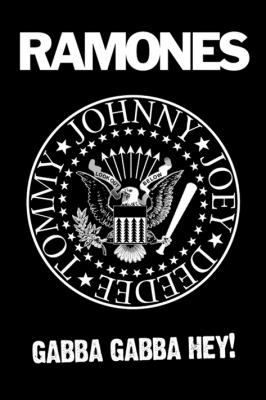
Now this series of lectures, where you talk about sexploitation and Nazi films, is this at all related to the upcoming VIDEO NASTY?
VIDEO NASTY was one evening of these film lectures. It’s ready, but we haven’t released it on DVD or anything, because it’s only a radio play. This one is a very straight – a radio play made on the stage with only one day of rehearsal. That was very rough. The funny thing is that it’s a radio play that works like an Italian zombie movie. For the German audience, the twist is that the actors onstage pretend to be actors in a bad Italian horror movie, and they are very well-known established stage play actors in Germany. If you don’t know that, then it might not be funny at all. Over here, it’s like you have these serious people, who do HAMLET and stuff like that, but now they are doing a Fulci zombie movie. Some of the actors are doing the dubbing voices of American actors. The main actress in VIDEO NASTY is the German voice for Angelina Jolie, for example. So you have these very strange combinations that only work in German, I’m afraid.
I want to talk a little bit about your documentary work. I know in MONSTERLAND, you cover a wide swath of the history of monsters in cinema and talk to such legends as Joe Dante, John Carpenter, H.R. Giger, Rick Baker, and Kenpachiro Satsuma. What was it like working with such genre icons? Can you tell us about your other documentary work, too?
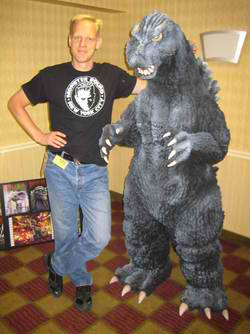
I was nervous. When you admire people, you have to hold back because you don’t want to look like a fanboy. So this was a very strange thing. One that went very well was H.R. Giger, the ALIEN designer, because he’s very shy. I worked with him on a German comedy called KILLER CONDOM, which was picked up by Troma for the US. And he was called the Creative Consultant, and I did the special effects, so we kinda worked together- which means we had dinner together and talked about stuff. He liked my movies a lot, and when he saw SCHRAMM he said it was one of his favorite movies. So it was this kind of connection I already had that made the interview with H.R. Giger much easier for me, because normally he’s not very happy with giving interviews at all. And after MONSTERLAND, he was not happy also: “Do I look like this?!” because he’s so shy.
But for me, the most interesting things were being in Japan and talking to people like Kenpachiro Satsuma, who portrayed GODZILLA and stuff like this. Meeting Joe Dante was really something normal, because he’s so open. He just talks to you, and shows you his little summer house next to his pool, all of the old Roger Corman posters his wall, and the old dusty Gremlin in the corner. So this was very easy. But in the end, I think Joe Dante didn’t know who I was. I gave him this book about NEKROMANTIK as a “Thank You” for the interview, and he was giving me funny looks: “You did this?!’ And I said “Yes.” And he gave me another funny look and we went off. So I never knew if he was impressed or shocked. But he didn’t believe me, for some reason.

MONSTERLAND was made for a TV channel called Arte. It’s a two country channel – Germany and France. And I also did some documentary work for them on a series called INTO THE NIGHT. The concept is two famous people spend the night together and we follow them with a camera. I did this with Asia Argento and Joe Coleman in New York. Have you seen that?
I watched some of them. I was very jealous that you got to work with Asia Argento. I’m guessing you will not give me her phone number.
I don’t have it. It was very complicated. If you do stuff like this for German and French TV, it’s complicated. You have to have this kind of commercial appeal, because it’s on TV. My idea was to do something about Joe Coleman, because I’m a big fan. I asked him if he wanted to do it and he said, “Yes. You’re the guy who did NEKROMANTIK. Of course, I’ll do it.” I told him that we needed someone for him as company for the night in New York: someone that might be more glamorous, so that the people from France would give me the budget. I asked him to get in contact with Asia Argento, because he knows her and that’s what he did. So he kind of closed the deal for me.
What normally do you have them discussing? Is it what comes organically, or is it about film or art?
That’s just up to them. We only ask them up front: What do you want to do? What do you want to eat? In what city to you want to spend the night? Then we try to arrange all the places for them; where we want to shoot. Then they do it in one go with no cuts. The good thing is that you shoot eight or ten hours and the movie is finished. The hard part for me, as the director, is to watch all the parts we shot. That’s two or three cameras at once – so 24 hours of footage; listen to all the stuff they talked about and get 53 minutes out of it. After that, you know these people very well. You only have about ten days of editing.
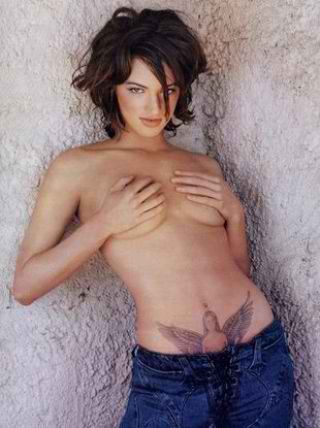
There’s a good thing about INTO THE NIGHT, because every hour you go to a different place and always the subject changes. After you listen to all the stuff and you do your notes, then you see if there’s a big theme or not. So it works on its own. It’s a lot of work, but it’s fun. You are going to listen even when they are driving in a car. You listen to people you are interested in, and that’s really exciting.
I think there would be an audience for that, because people have voyeuristic tendencies to begin with, and then you involve celebrities that they admire. You kind of get a look into how their thoughts work.
These kinds of programs are not sold to other countries very much. Some of them have been released on DVD over here. They are aired in France, Germany, Switzerland, and Austria only, I think – only in four countries.
It’s probably not over here because I think something like that would fall under reality television. We have a rule in America that if it’s reality television, it has to be as stupid as possible. So if it’s something that’s actually going to challenge or educate us, it’s forbidden. It can’t cross the border.
I see. So there’s no use in even asking.
As we discuss your work, NEKROMANTIK obviously keeps coming up. It might be that one day you are six feet under and your tombstone will simply read, “The guy who did NEKROMANTIK.” Deep down, are there any regrets about being the guy who did NEKROMANTIK? Do you wish you were defined in some other way?
In a way, this would make sense if NEKROMANTIK was a phenomenon like TWILIGHT or something. Something that is really big. As I was trying to explain to you, a lot of people talk to me about it, but it’s not big. It’s still an underground movie after all these years. I don’t get recognized on the street. If I go on a TV show next week over here in Germany, I just talk about the new stage play. It comes from the outside – from America and places like this – because over there, that’s the only stuff that’s visible from me. It’s very good that the fame with NEKROMANTIK is in the international market, because at home it’s not bothering me at all. Of course, a lot of people that hire me tell me, “I saw your film twenty years ago. I was shocked and I hated it, but do you want to work with me now?” In a way, it helps. But for a certain period of time, it was the opposite. My films were banned over here. Nobody was giving me jobs, of course. Everyone was afraid that if they hired this guy that they wouldn’t be able to sell the product afterwards.
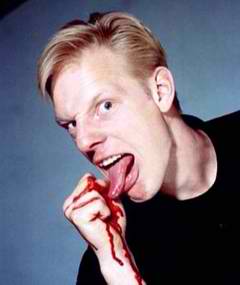
Would you be where you are today without NEKROMANTIK?
That’s very hard to say. Even the theater attendant – guy who runs the theater in Germany – is a fan of mine from the early days and he hired me to do stage plays now. You can see that if I had been a serious stage play director in the first place, it might have been more difficult. But then I would probably do more classical stuff, not SEXMONSTER and GREEN FRANKENSTEIN on the stage. It’s very hard to say. In short, I think I was lucky that NEKROMANTIK got so much attention in one way, and then unlucky in another way because I had lots of trouble with it. This trouble was nearly being prosecuted for it and having my home raided by the police. Stuff like this also makes headlines for you. We have even been on the front page of Variety with the court case about NEKROMANTIK.
They actually raided your home back in the day?
Yes. They were trying to get hold of the negative in order to destroy it.
Wow. You have another facet to add to your career that many can’t identify with. I spoke with Stuart Gordon, and he’s a director whose tombstone might read, “This guy did RE-ANIMATOR.” But I’m pretty sure that he never had his home raided over it.
When I met him for the first time in South Korea, we were both on the jury at a festival in 2004. He told me that he worked for Disney. It was totally unbelievable for me that someone who did RE-ANIMATOR worked a steady job for Disney. Over here, it wouldn’t work like that. You are stigmatized if you do something like NEKROMANTIK over here. You don’t get jobs afterwards. It’s funny because I still have the laserdisc of RE-ANIMATOR that he sent to me, before I actually met him. He sent it from his office at Disney Studios. I thought that there was something wrong and I would have to ask him about it when I saw him. When I met him in South Korea, he was just this nice, fatherly guy. He doesn’t look like someone who did this insane movie. You can see that, in the US, you have a culture for this kind of thing. You don’t get suspicious about someone doing a movie like NEKROMANTIK. Over here it’s something bad. RE-ANIMATOR was banned in Germany as well.
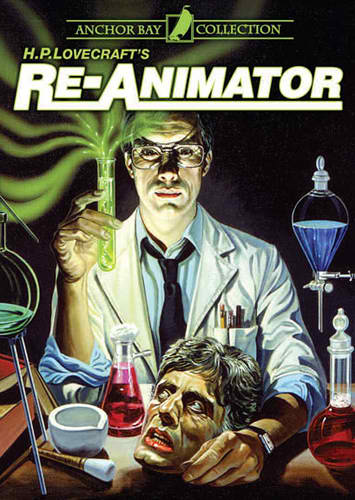
Twenty-five years after NEKROMANTIK, do you feel that the audience is more jaded or cynical? Is it harder to shock them?
I don’t know because I don’t try to shock them anymore.
You got out of that game.
Yes, because I did it so well that nowadays I’m trying to make fun of the expectation that I shock people. You saw the trailer of the stage play. Of course if it’s based on a radio play and it’s only the soundtrack of a movie you don’t see – there is no blood. Afterwards, the guy from the theater told me, “When I hired you, I was expecting a lot of blood on stage.” I did the opposite. I was showing nothing and I was showing something that was making fun of it. He was shocked by that, of course. It didn’t match his expectations. That has always been something fun for me to do – disappoint people’s expectations. If you have a look at NEKROMANTIK 2, you can imagine how painful it must be for the gorehounds to sit through these comedy scenes, until something is finally happening.
I don’t know if you keep up with it at all, but in the first HUMAN CENITPEDE, there’s hardly any gore. People were surprised. But in the second one, Tom Six showed you everything you expected to see in the first. Then everyone thought, “That’s horrible. I didn’t want to see that.” But I think they did. It was an interesting experiment, and what you are saying kind of reminds me of that. Have you seen either of these films?
I’ve not seen either HUMAN CENTIPEDE. As a writer for film magazines, I see all horror films that are going to be released in Germany. But these films are not released in Germany, because you can’t release them over here. After twenty-five years, TEXAS CHAIN SAW MASSACRE has finally been released uncut. I did a big special for it on DVD. Can you imagine a film from 1974 being released in 2012 for the first time?
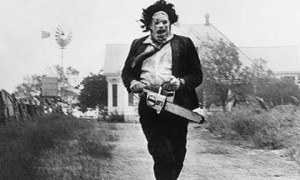
No. That was one of the first films that blew my mind.
Mine, too. But I was also kind of disappointed when I first saw it, because there’s no blood. In the seventies, the film was at the cinema. That was OK, but as soon as a video came out, it was banned all over Germany. That’s what happened in the eighties.
What are you currently working on? What’s next on the docket for you?
I just finished this BEAST OF FUSKUSHIMA thing, and I am now preparing a stage play about Edward Gein.
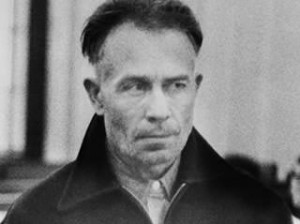
What’s that going to be called?
KANIBALE UND LIEBE (ed: CANNIBALS AND LOVE). There is a famous stage work by Schiller called KABALE UND LIEBE (ed: INTRIGUE AND LOVE), so this is a joke on high art stage plays.
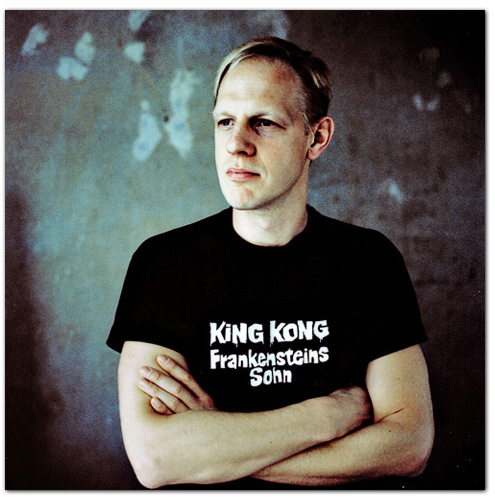
More to come, Bastards! - dailygrindhouse.com
Interview with Jörg Buttgereit
Illustration: Rainer Engel
Soiled Sinema is very pleased to bring you an interview with German auteur Jörg Buttgereit of Nekromantik fame. It is not an exaggeration for us at SS to say that Jörg Buttgereit is one of our favorite directors and without groundbreaking filmmakers like him, this website would not exist.
After a 16 year hiatus from feature-length filmmaking, Buttgereit released CAPTAIN BERLIN VS. HITLER. Following in the tradition of German filmmakers like Hans-Jürgen Syberberg, CAPTAIN BERLIN VS. HITLER was shot on a stage-play.
set of Nekromantik (C) Jörg Buttgereit
SS: When I first discovered your work, I was amazed by your keen ability to successfully combine sex and death in an artistic manner whilst still maintaining a sense of humor. Personally, I think you're a modern auteur coming from a rich tradition of German cinema. Believe it or not, your films (especially Nekromantik) remind of the great silent German expressionist masterpieces, in their ability to hypnotize and transport the viewer to a transcendent world of the macabre. When I watch a German film like Run Lola Run, it seems like the same film could have been made in Hollywood or France. Do you see yourself as a culturally German filmmaker (to any degree), influenced by your native land and culture? Was your own style of filmmaking influenced by German filmmakers of the past, whether it be the German expressionists or German New Wave or any other German film movement/genre?
JB: Its
hard to judge your own influence. I think it is quite normal to check
out your own limits when you are young. That is why Horror-movies are so
appealing to younger people. But NEKROMANTIK was also a protest against
the strict censorship movement in Germany. During the 80s all Horror
films where cut or banned in Germany and we where fighting for our right
to get those movies uncensored in our country. Adults should decide on
their own what they want to see and what not. Censorship can´t prevent
people from seeing what they want anyway. It´s an old fashioned concept
that does not work anymore. I was not so much influenced by other
movies. Real live Horror was always more disturbing to me. I think it is
important for my films that they are shot on actual film stock. The
grainy 16mm and Super 8 film stock definitely works for the atmosphere
of the films. We did a lot of screen-tests with the prop of the corpse
before choosing the right film stock for NEKROMANTIK. It was very
important to me to have a believable atmosphere for my story.
(C) Jörg Buttgereit
SS: In an interview featured in the book Sex, Murder, Art: The Films of Joerg Buttgereit, you mentioned that German audiences are not too fond of German films/filmmakers unless the directors are dead (like Fassbinder) or the films are praised by international critics. Why do you think Germans react this way to films created by their fellow countrymen? Over the years, has your popularity and status as a filmmaker increased in Germany? Do you have a strong and loyal German fan base?
JB: I
do have a fan base in Germany that follows my work in Radio Plays,
acting and all the books and film reviews I do. That part of my work
that is invisible to my fans outside of Germany ´cause its all in German
language. Over here I am more known as a maker of Stage-plays and
radio-plays.
SS: I know that you traveled to Japan to write an extensive book on Japanese Monster films. Do you have plans for writing more books in the future, whether it be on film or otherwise?
JB: I am more involved in new projects for the stage which is very exciting to me.
(C) Jörg Buttgereit
SS: You originally introduced Captain Berlin in a short of the same name in 1982. In 2009, you released CAPTAIN BERLIN VS. HITLER. How did the creative process come about for CAPTAIN BERLIN VS. HITLER? Were you always planning to do a feature-length film about the adventures of Captain Berlin? Do you have plans for any new Captain Berlin films in the future?
JB: I
think the fun of CAPTAIN BERLIN VERSUS HITLER is the fact that it is a
stage-play that was filmed for a DVD release. The plot goes like this:
Adolf Hitler’s brain has survived. The crazy Nazi-doctor Ilse von
Blitzen hires the master of life and death: Dracula himself. He is
supposed to resuscitate Teutonic human material with his bite. The
reward that has been chosen is the virgin Maria – Captain Berlin’s
daughter. Superhero Captain Berlin now has to confront these two
monsters. Since the 1940s he wants to eliminate Hitler, but now he first
has to save his daughter from the vampire. I documented the play on
video and made a film out of it. Its a mix between film and stage-play
and it is available on DVD with English subtitles from the German
distributor "media target". Extras include my old Super 8 shorts
“Captain Berlin” + “Captain Berlin vs Hyxar”, a backstage report, a film
about the world premiere, a photo gallery and a comic based on the
film. The DVD is region-free. The films looks a little bit like one of
those crazy Mexican wrestler movies. I really can`t think of getting
money for a real feature film with Captain Berlin. But who knows...
SS: Was there any controversy in Germany when you released CAPTAIN BERLIN VS. HITLER regarding Adolf Hitler (despite obviously being negatively portrayed)? Additionally, did anyone in Germany criticize the Nazi-exploitation parody in Der Todesking, the Hitler Youth outfit worn by Monika in Schramm, or your early short BLOODY EXCESS IN THE LEADERS BUNKER?
JB: There
was no real controversy about me dealing with Hitler. If you do
something on stage in Germany it is labeled as art and you are free to
express yourself. Regarding my films, the depiction of violence was
more difficult to deal with.
SS: I have read past interviews where you spoke about the possibility of a third Nekromantik film? Will there be a Nekromantik trilogy? Also, do you have any other film projects planned for the future that we can anticipate?
JB: You
have to keep in mind that because of censorship restrictions my films
are still only legally available in a handful of countries. I don´t see
how to get my money back for an independent film like NEKROMANTIK
nowadays. If I would do a part 3 it would be all over the internet the
day after a DVD release. Bootlegs and illegal downloads have made it
impossible for me to do independent films like I did in the 1980s.
- www.soiledsinema.com
(C) Jörg Buttgereit
Nekromantik II: Return of the Loving Dead (C) Jörg Buttgereit
Nekromantik II: Return of the Loving Dead (C) Jörg Buttgereit
Manfred O. Jelinski is best known
in the horror cinema world for his collaborations with German auteur
director Jörg Buttgereit. Jelinski was the producer behind Nekromantik, Der Todesking, Nekromantik II: Return of the Loving Dead, and Schramm.
Jelinski also worked as a cinematographer, editor, and even as an
actor during his collaborations with Buttgereit. Soiled Sinema is very
pleased to bring you this interview with Manfred O. Jelinski.
SS:
How did your filmmaking partnership/collaboration come about with Jörg
Buttgereit? Did you know Buttgereit before you first collaborated with
him on the original Nekromantik film?
MJ: Uwe
Bohrer and I had a company for Film Service since the late seventies.
We designed a way of filmmaking on a nearly no budget basis. After we
had everything under control, we looked out for a potential director.
Jörg Buttgereit was a customer who needed film copies from us. I noticed
he had potential and I liked his films, so I asked him to make a film.
It turned out very well.
(C) Jörg Buttgereit
SS: What is your favorite film that you worked with Buttgereit on? Why that particular film?
MJ: I
like Schramm very much. Everything came easy. Watch the making of
Schramm. We had developed a deep understanding of filmmaking by the time
we made Schramm. Most problems we had were with Nekromantik: At the
set, with the editing, with every part. But it was fun in the end to see
it all come together. Actually, none of the films were a problem. Each
one gave me new inspiration. Each one was special.
SS: Nekromantik II
was the first film seized in Germany since the Nazi era. What kind of
trouble did you get into with Nekromantik II? Is the film still banned
in Germany today?
MJ:
We were accused, but won in the end. So it was never really banned but
it always sounds fine for advertisement. But we had to work about a year
to make the film... illegally. It's difficult to explain, needs more
space. We had spread the material, negatives, prints among six of our
friends, a hidden flat etc. Man, what a time!
(C) Jörg Buttgereit
SS:
Personally, the films you created with Buttgereit remind me of German
expressionist films due to their dark, yet powerful expressive
aesthetic. Are you a fan of German expressionist films from directors
to F.W. Murnau, Fritz Lang, Robert Wiene, etc.?
MJ: No. Not really. I like Murnau and Lang as heroes of their time and expression. But I always tried not to copy someone's style.
SS:
Are there any horror films from the so called "German New Wave"
movement that inspired you and/or that your liked? For example, did
Lommel's "The Tenderness of Wolves" (which was a loose remake of Fritz Lang's "M") inspire you?
MJ: No.
Same reason as above. I avoided seeing too many films. They leave to
big of an impression on the brain. To admire someone doesn't mean to
copy him. Each film needs its own unique design.
(C) Manfred O. Jelinski
SS: Besides producing films, you have also directed a couple films. Can you tell us about the short "mein Schones Husum" and the documentary "So war das S.O.36?" Are these films currently available with English subtitles?
MJ: No.
Husum is a short which shows a local city in an unconventional light.
SO36 is about German Punk Music, stuff that no one would be interested
in seeing outside of Germany.
SS: You were the cinematographer behind the beautifully shot films Der Todesking, Nekromantik II, and Schramm. Did any particular cinematographers inspire your style of filmmaking?
MJ: Not
really. I tried to avoid it. I love Antonioni, Kubrick and Polanski
(and Russ Meyer). But for Low budget films you need different concepts.
You have different materials of stock, less light, people to handle and
so on. You cannot stylize low-budget films in a way similar to
Hollywood.
(C) Jörg Buttgereit
SS:
Are there any particular German filmmakers from the past that your
admire? Aside from German filmmakers, do you have an other favorite
filmmakers (from around the world)?
MJ: Well, I don't know. If I really grab inside my mind, I would say, I admire Wenzel Storch. He is outstanding and lovingly crazy.
SS: Would you like to create a third Nekromantik film with Buttgereit? Also, do you hope to work with Buttgereit on new films in the future?
MJ: Well,
we talked about. All the actors and other people that have survived
would love it. In fact, that is not the point which drives a decision.
We are not sure if it will work ... in many ways. On the other hand, I
would not be able to split from my family for long because I have two
very little children. (But "Yes!", said my wife.)
(C) Jörg Buttgereit
SS: I noticed that you sell Spanish director Nacho Cerda's 1994 film "Aftermath" on your site "Jelinski & Buttgereit." Are you a fan of "Aftermath?" Are you friends with Cerda?
MJ: We shot the interview with Jörg at my house in North Frisia. Nacho is a nice guy, really. We had fun.
SS: Are there any contemporary German horror films/film directors that you can recommend?
MJ: No. Ask Jörg, he is more into that. I don`t like "horror", it has limited dimensions.
Nekromantik (C) Jörg Buttgereit
SS: Do you have any upcoming film projects in the works?
MJ: I'm
writing books now. Very different stuff. Remote Viewing and Quantum
physics. Scientific stuff and novels. As for my novels, people say you
can read them like films. Whatever that means. -
www.soiledsinema.com
















Nema komentara:
Objavi komentar